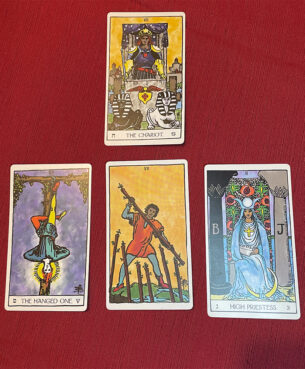A march in honor of the orisha Eshu drew some 150,000 people in São Paulo recently, considered a rebuke to the rise of evangelical Christians’ political power.

People attend the March for Eshu, Aug. 18, 2024, in São Paulo, Brazil. (Video screen grab)
By Eduardo Campos Lima
SÃO PAULO, Brazil — A march in honor of an Afro-Brazilian deity drew some 150,000 people in São Paulo on Aug. 18, shocking many in this historically Catholic country that has witnessed the growing numbers and political power of evangelical Christians.
The March for Eshu, honoring a West African Yoruba orisha, was widely interpreted as a rebuke to the evangelicals who are credited by political analysts with securing the presidency for conservative politician Jair Bolsonaro in 2018, much in the way American evangelicals championed Donald Trump. Bolsonaro has cited Trump as a model in the governing style as well.
In the Bolsonaro era and since — Bolsonaro lost his bid for a second term to Luiz Inácio Lula da Silva in 2022 — signs of evangelical Christians’ ascendancy have been everywhere, from the omnipresence of televangelists on the airwaves to the crucifixes and the Bible displayed in government offices to the 30-year-old March for Jesus, at which millions fill city streets around Brazil.
In marching for Eshu, adherents of Afro-Brazilian religions showed themselves ready to make their voices heard. “My idea was to combat intolerance against my faith. But not through confrontation. I just wanted to show the size of our creed and of our people,” said 32-year-old social media influencer and businessman Jonathan Pires, who organized the march.
Pires said he was disturbed by the way evangelicals have demonized his spirituality. Illegal in colonial times, the faiths brought by enslaved Africans to Brazil before slavery was outlawed in the late 1800s were practiced secretly, and orishas were often venerated after being renamed for Catholic saints. During Bolsonaro’s tenure (2019-2022), verbal and physical aggressions against those people grew exponentially.
Adherents of Afro-Brazilian faiths, which include Candomblé and Umbanda, were historically marginalized — and, many say, unrepresented: Out of fear and shame, many told surveyors they were Catholic.
Eshu has different aspects in Candomblé, which views him as an orisha, and in Umbanda, in which Eshu is an ancestral force, one often associated with bohemians and outcasts.
In either faith, said Maria Elise Rivas, a yalorisha (or priestess) of both Umbanda and Candomblé, “he’s a force with uncontrollable power, something that transforms him into a kind of transgressor, a manipulator and a destroyer.” He is also a messenger who mediates between humans and the gods.
In all this, Rivas pointed out, Eshu is problematic for monotheistic faiths and is often portrayed as a devil by Christians. “Those traditions have rigid rules, but for Eshu everything is flexible,” said Rivas. “There’s no idea of right and wrong, but a conception of building endless possibilities.”
Taking Eshu to the street, like the March for Eshu did, also challenged the racial and economic divisions in Brazilian society. A march made sense, said Rivas, “because the street doesn’t belong to anybody in particular, it belongs to all races and classes, and that’s the essence of Eshu.”

Jonathan Pires, center holding child, participates in the March for Eshu, Aug. 18, 2024, in São Paulo, Brazil. (Photo courtesy of Jonathan Pires)
Social media has allowed followers of Afro-Brazilian traditions to unite against oppression and organize against attacks on them. In the past few years, Pires has become an activist on believers’ behalf. He created a bumper sticker reading: “It has never been luck, it has always been macumba,” a retort to familiar bumper stickers on Christians’ car bearing slogans like: “It has never been luck, it has always been Jesus.” (A macumba is a percussion instrument used in Candomblé rituals and a slur, positively reappropriated in the bumper sticker, for an adherent for an Afro-Brazilian faith.)
“Many people see our religion as one of poverty. I want to show to everybody that we’re also prosperous, given that Eshu opens the way for us,” Pires said.
His work on social media has earned him more than 600,000 followers on Instagram, which he uses not only to talk about religion, but to advertise his charitable work. When floods devastated the state of Rio Grande do Sul earlier this year, Pires managed to collect 120 tons of food and other basic items for those impacted, and he and his family spent more than two weeks in the region helping to distribute aid kits to flooded areas.
“That was also a way of demonstrating that Eshu is not about bad energies, like many people think. He feeds us and elevates us,” Pires said.
He said he paid for the costs of the march and refused when politicians offered their support. “Eshu is not a supporter of (Lula da Silva’s) Workers’ Party nor a supporter of Bolsonaro. My party is Eshu,” Pires said.
On social media, however, many people associated the march with the left wing, in part because Pires asked participants to wear red, one of Eshu’s ceremonial colors, but also the color of the Workers’ Party.
But Caio Fábio, a prominent evangelical pastor who has become a critic of the religious right, pointed out that, given the Brazilian right wing’s close ties to evangelicals and conservative Catholics, the March for Jesus has become regarded as a political rally for rightist politicians such as Bolsonaro. “The March for Jesus has always been ideological and political,” Fábio said.
“It became a perverted event, full of politics. And that phenomenon was accompanied, of course, by the deterioration of the Pentecostal and neo-Pentecostal churches, which also became aggressively politicized.”
Ironically, he said, Pentecostal and neo-Pentecostal churches have long assimilated elements of the Afro-Brazilian religions as they tried to convert their adherents. The frantic circular dance known among evangelicals as the reteté accompanies their speaking in tongues as they feel the presence of the Holy Spirit, a usual component of neo-Pentecostal celebrations many times associated to African-Brazilian religions.
“Many people left their original African Brazilian creeds and began to frequent evangelical churches, which scandalously appropriated some of their ritual forms,” Fabio said.
But many, he added, especially the youth, are returning to Umbanda or Candomblé because of the politicization of the evangelical churches.
Pires said that since the first March for Eshu in 2023, people are becoming more comfortable with outwardly showing their Umbanda or Candomblé faith. “More and more Camdomblé or Umbanda practitioners feel comfortable to wear our traditional bead necklaces on the street. People used to be afraid or ashamed of doing so,” he said.
Ivanir dos Santos, a Candomblé leader in Rio de Janeiro and a longtime opponent of religious intolerance, said the March for Eshu is a natural reaction from a people who can’t stand to be attacked anymore.
“The March for Jesus has a conservative, moralistic, homophobic and intolerant agenda. That segment reacted in order to elevate its own self-esteem,” he told RNS.
Dos Santos has argued for opposing intolerance not through marches of Afro-Brazilian believers alone, but a variety faiths. “That’s why I defend the idea of promoting walks that join people from other creeds and social segments that promote freedom and democracy, instead of marches,” he said.
Pires said that he met a number of Catholic priests and evangelical pastors at his march, but some experts said the opposition had to begin with Eshu.
“The African Brazilian religions have a marvelous ability of resisting,” said Rivas. “And Eshu is a great reference in that process, because he is the one who rebuilds reality for all the people, no matter who they are.









 © Provided by Refinery29
© Provided by Refinery29
/cdn.vox-cdn.com/uploads/chorus_image/image/67140237/Screen_Shot_2020_07_31_at_3.43.16_PM.0.png)
:no_upscale()/cdn.vox-cdn.com/uploads/chorus_asset/file/21524012/shutterstock_1544455061.jpg)
:no_upscale()/cdn.vox-cdn.com/uploads/chorus_asset/file/7154411/lemonade.jpg)
:no_upscale()/cdn.vox-cdn.com/uploads/chorus_asset/file/7920901/B_VENUS_NEW_03_FINAL_06.jpg)
:no_upscale()/cdn.vox-cdn.com/uploads/chorus_asset/file/21523967/644429694.jpg.jpg)
:no_upscale()/cdn.vox-cdn.com/uploads/chorus_asset/file/21646628/SPIRIT_01.jpg)
/cdn.vox-cdn.com/uploads/chorus_image/image/67137409/IMG_3248.0.jpg)